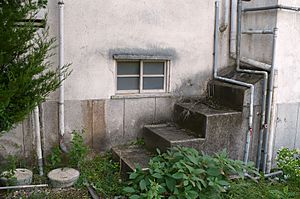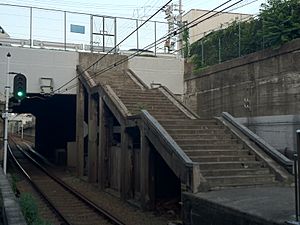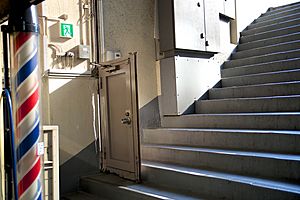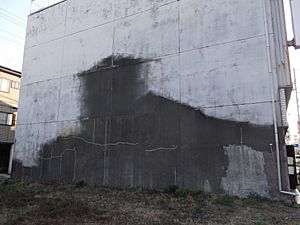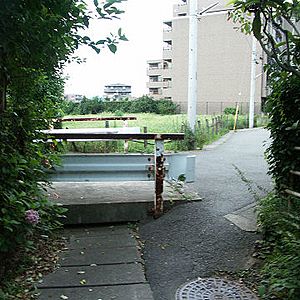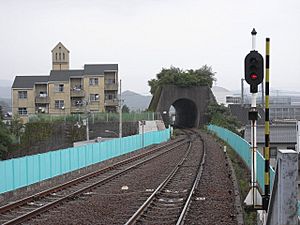Hyperart Thomasson facts for kids
Thomasson or Hyperart Thomasson is a cool idea from Japanese artist Akasegawa Genpei in the 1980s. It describes something useless that is still kept as part of a building or city. These objects become like art, even though no one made them to be art. Akasegawa called them "hyperart" because they seemed even more like art than actual art. People have become interested in Thomasson again, especially since Akasegawa's book was translated into English in 2010.
What Does "Thomasson" Mean?
The name Thomasson comes from a baseball player named Gary Thomasson. He played for the Yomiuri Giants and was paid a lot of money. But he didn't play very well and almost set a record for strikeouts. Akasegawa thought Thomasson's useless role on the team was a perfect way to describe these strange objects. They were kept in good shape but had no real purpose, almost like a piece of art.
In Japanese, the word Tomason can mean one or many objects. So, in English, Thomasson can also refer to one or many of these items. Sometimes you might see it spelled Tomason or Thomason.
How Thomasson Started
Akasegawa found the very first Thomasson in 1972 in Yotsuya, Tokyo. He saw a staircase that went up but had no door or entrance at the top. Even stranger, the handrail of the staircase looked like it had been fixed. This showed someone was still taking care of it, even though it was useless.
The next year, Akasegawa found a ticket window at Ekoda station that was boarded up. The wood used to cover it was cut perfectly to fit the old stone counter. Another artist, Minami Shindō, found a gate at a hospital in Ochanomizu. This gate was completely filled with concrete, but the gate itself was still in good condition.
The artists gave these objects fun names. They called them "The pure staircase of Yotsuya" and "The useless window of Ekoda." They called all these things "hyperart." They noticed these objects were like art because they had no purpose. But they were also cared for, like they were on display. The interesting part was that no one seemed to have created them on purpose. This made them even more "art-like" than regular art. Hyperart cannot be made by an artist. It can only be found and noticed by someone looking closely.
The objects that were part of buildings or the city were named "Thomasson." Akasegawa and his students picked the name during a class. At that time, Gary Thomasson's strikeout record was 132.
The idea of Thomasson became known to everyone in 1982. This happened through articles in a magazine called Shashin Jidai (Photo Times). The articles showed things found by Akasegawa's students. They also had photos of objects Akasegawa found himself. Readers even sent in their own Thomasson discoveries. These articles started a "Thomasson Boom," and the idea quickly became popular. The early articles were later published as a book called Chōgeijutsu Tomason.
Thomasson's Impact and Comeback
The Thomasson boom had a big effect on students and young people. Even people who didn't fully understand it started using the word "Thomasson." This showed how popular the idea became. The book Chōgeijutsu Tomason featured a lost neighborhood in Tokyo on its cover. This area had disappeared because of new building projects. This story captured the spirit of Thomasson. It also showed how fast cities were changing during Japan's "bubble economy." Finding Thomasson was a way to see human marks on the city. These marks were quickly being erased by new construction.
In 1983, the Thomasson Observation Center held an art show. It was called "Cityscape in Anguish" and took place in Shinjuku. The show displayed Akasegawa's paintings and photos of Thomasson. These photos were taken by Akasegawa, his students, and magazine readers. Other events like Thomasson bus tours and talks by Akasegawa also happened. The Japanese TV channel NHK even covered the topic. The publication of the full Chōgeijutsu Tomason book in 1987 was the peak of the Thomasson boom.
Other artists and thinkers were doing similar projects around this time. For example, Terunobu Fujimori looked for interesting architecture. Hayashi Jōji collected manhole covers. These projects led to a book called Manual on Street Observation in 1986. A special event was held to promote this new "Street Observation Society."
After the Street Observation Society appeared, Thomasson became less visible to the public. The Thomasson Observation Center, run by Akasegawa and his students, stopped its activities. They were overwhelmed by all the attention.
However, Thomasson was still mentioned in movies and books. The 1989 film Patlabor: The Movie showed an "Atom-bomb type" Thomasson. The science fiction novel Virtual Light by William Gibson also talked about Thomasson many times.
In 2010, Akasegawa's book Chōgeijutsu Tomason was translated into English as Hyperart: Thomasson. In 2012, the Thomasson Observation Center started a Facebook page. They began accepting new Thomasson discoveries online. People shared these posts widely. A special form was even made to help people report new Thomasson finds. This started a new Thomasson movement for the internet age. Many English-language news outlets have covered the book and the idea.
In 2013, the Thomasson Observation Center held a big Thomasson Exhibition. It was in Shinjuku, Tokyo, to celebrate 31 years since its start.
Historian Jordan Sand also wrote about Thomasson in his 2013 book, Tokyo Vernacular. He discussed it in a chapter called "Deviant Properties: Street Observation Studies." Sand also wrote an essay for the 2010 English translation of Hyperart: Thomasson.
In 2013, an art show in Brooklyn called "La Poussière de soleils" featured Thomasson. It showed a copy of Akasegawa's photo of a door handle sticking out of a cement wall.
Different Kinds of Thomasson
These types are based on the "Thomasson Illustrated Encyclopedia."
The Useless Staircase
This is also called a Pure Staircase. It's a staircase that just goes up and down, but leads nowhere. Most of these used to have a door at the top. Some useless staircases were even built useless by mistake.
The Useless Doorway
Even if it's blocked up, a Useless Doorway still looks important. Sometimes, a Useless Doorway is in a place where it's not needed at all, with no wall or fence around it.
The Hisashi
"Hisashi" means "eaves" in Japanese. This type refers to useless eaves. These are roof parts that no longer have a window or door under them to protect from rain.
The Useless Window
This is a window that has been blocked up. It still looks nice because someone took care to block it up neatly.
The Nurikabe
"Nurikabe" means "plaster wall" in Japanese. This type is similar to Useless Doorways and Windows. It's when a door or window was supposed to be completely sealed with concrete. But you can still see a difference between it and the wall around it.
The A-bomb Type
This is a flat (2-D) Thomasson. It's the outline of a building left on a wall. You can see this when a building next to it is torn down. If these outlines appear because of water, they are called hydrogen bombs. If they appear when a sign is taken down, they are called neutron bombs.
The Elevated Type
These objects are normal by themselves. But they are placed in a much higher than usual spot, which makes them look strange. For example, a door with a handle on the second floor of a wall. These often appear when staircases are removed. They can also happen when a crane is kept inside a building, but a regular door is used on the outside.
The Outie
This is something that sticks out from a sealed wall. It could be a doorknob or a water tap.
The Uyama
This is a sign with some letters missing. The first example was a shop sign that only had the word "Uyama" left.
The Castella
"Castella" is a Japanese sponge cake. This type is a rectangular shape that sticks out from a wall. For example, a blocked-up window that bulges out. The opposite, a sunken blocked-up section, is called a Reverse Castella.
The Atago
This is an object sticking out by the side of the road with no clear use. It might have been used to stop cars from parking. The first one was found by Akasegawa while walking from Shinbashi to Atago.
The Live Burial
This is an object by the road that is partly covered in concrete.
The Geological Layer
This is a patch of ground that is a different height from the area around it. This usually happens when many building projects have taken place there.
The Boundary
This is a guardrail, fence, or wall whose purpose isn't clear right away.
The Twist
This is a part of a building that should be straight but is slightly twisted. This often happens when something meant to be straight is used at an angle.
The Abe Sada
This is what's left of a telephone pole after it has been cut down.
The Devouring Tree
This is a tree that grows around and absorbs part of a fence or wire. This isn't very rare. If humans weren't involved, it's just nature, not a Thomasson. This is also called the Stubborn Nature Type.
The Useless Bridge
This is a bridge over a river that has been filled in, or a bridge that has become useless. Sometimes, a bridge is still needed for cars to cross over covered drains. These are not Useless Bridges, as they only seem useless.
The Pure Type
This is an object that is hard to put into any other category. You just can't figure out its use. For example, "Pure Shutters" open to show a blank wall. A "Pure Tunnel" exists without a hill around it. The Pure Staircase of Yotsuya is a good example of this type.
Evaporation
This is when the color on a sign fades, or a monument has missing parts. It's an object whose meaning has become hard to understand. This often happens because the object's material lasts a long time. It also occurs when important words on a sign, painted in red, disappear. This makes the rest of the sign hard to read.
See also
 In Spanish: Thomasson (arte) para niños
In Spanish: Thomasson (arte) para niños
- Bridge to nowhere


